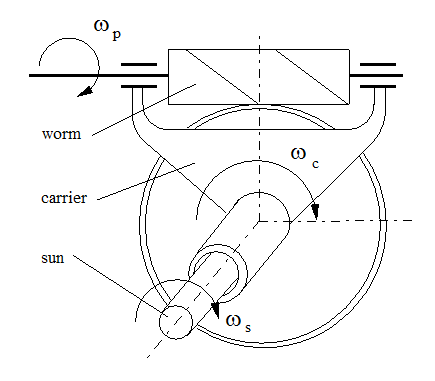Sun-Planet Worm Gear
Planetary gear set of carrier, worm planet, and sun wheels with adjustable gear ratio, worm thread type, and friction losses
Libraries:
Simscape /
Driveline /
Gears /
Planetary Subcomponents
Description
The Sun-Planet Worm Gear block represents a two-degree-of-freedom planetary gear built from a carrier and sun and planet gears. By type, the sun and planet gears are crossed helical spur gears arranged as a worm drive, in which the planet gear is the worm. Such transmissions are used in the Torsen® T-1 differential. When transmitting power, the sun gear can be independently rotated by the worm (planet) gear, by the carrier, or by both.

You specify a fixed gear ratio, which signifies the worm angular velocity divided by the sun gear angular velocity. You control the direction by setting the worm thread type to left-hand or right-hand. Rotation of the right-hand worm in the positive direction causes the sun gear to rotate in the positive direction. The positive directions of the sun gear and the carrier are the same.
Thermal Model
You can model
the effects of heat flow and temperature change by enabling the optional thermal port. To enable
the port, set Friction model to Temperature-dependent
efficiency.
Equations
Equation variables are:
| RWG | Gear ratio that signifies the worm angular velocity divided by the sun gear angular velocity: The ratio is positive for the right-hand worm and negative for the left-hand worm |
| ωS | Angular velocity of the sun gear |
| ωP | Angular velocity of the worm gear |
| ωC | Angular velocity of the carrier |
| ωSC | Angular velocity of the sun gear with respect to the carrier |
| α | Normal pressure angle |
| λ | Worm lead angle |
| L | Worm lead |
| d | Worm pitch diameter |
| τS | Torque applied to sun shaft |
| τP | Torque applied to planet shaft |
| τC | Torque applied to carrier shaft |
| τ | Torque due to meshing friction: The loss depends on the device efficiency and the power flow direction. To avoid an abrupt change of the friction torque at ωS = 0, the friction torque is introduced via the hyperbolic function. |
| τinstfr | Instantaneous value of the friction torque used to simulate friction losses |
| τfr | Torque due to friction in steady-state |
| k | Friction coefficient |
| ηWG | Efficiency of worm to gear power transfer |
| ηGW | Efficiency of gear to worm power transfer |
| pth | Power threshold |
| μSC | Viscous friction coefficient for the sun-carrier interface |
| μWC | Viscous friction coefficient for the worm-carrier interface |
The Sun-Planet Worm Gear block imposes one kinematic constraint on the three connected axes:
The gear has two independent degrees of freedom. The gear pair is (1,2) = (S,P).
The torque transfer is:
In the ideal case where there is no torque loss, τloss = 0.
In the nonideal case, τloss ≠ 0. For more information, see Model Gears with Losses.
In a nonideal gear, the angular velocity and geometric constraints are unchanged, but the transferred torque and power are reduced by:
Coulomb friction due to worm-sun gear meshing, which is characterized by the friction coefficient k or constant efficiencies [ηWG, ηGW]
Viscous couplings of driveshafts with bearings, which are parametrized by viscous friction coefficients μSC and μWC
Because the transmission incorporates a worm gear, the efficiencies are different for the direct and reverse power transfer. The table shows the value of the efficiency for all combinations of the power transfer.
| Driving Shaft | Driven Shaft | ||
| Planet | Sun | Carrier | |
| Planet | N/A | ηWG | ηWG |
| Sun | ηGW | N/A | No loss |
| Carrier | ηGW | No loss | N/A |
When you set Friction model to Constant
efficiency and leave Friction
parameterization set to Friction coefficient and
geometrical parameters, the model considers geometric surface
contact friction. In this case, ηWG
and ηGW rely on:
The worm-gear threading geometry, specified by lead angle λ and normal pressure angle α.
The surface contact friction coefficient k.
When you set Friction model to Constant
efficiency and set Friction
parameterization to Efficiencies, or
when you set Friction model to
Temperature-dependent efficiency, the model
treats the efficiencies as constant. In this case, you specify
ηWG and
ηGW independently of geometric
details.
You can enable self-locking behavior by making the efficiency negative. Power cannot be transmitted from the sun gear to the worm or from the carrier to the worm unless some torque is applied to the worm to release the train. In this case, the absolute value of the efficiency specifies the ratio at which the train is released. The smaller the train lead angle, the smaller the reverse efficiency.
The efficiencies, η, of meshing between the worm gear and planet gear are fully active only if the transmitted power is greater than the power threshold.
If the power is less than the threshold, the actual efficiency is automatically regularized to unity at zero velocity.
The viscous friction coefficients of the worm-carrier and sun-carrier bearings control the viscous friction torque experienced by the carrier from lubricated, nonideal gear threads. For details, see Nonideal Gear Constraints.
Variables
Use the Variables settings to set the priority and initial target values for the block variables before simulating. For more information, see Set Priority and Initial Target for Block Variables.
Assumptions and Limitations
Gear inertia is assumed to be negligible.
Gears are treated as rigid components.
Coulomb friction slows down simulation. For more information, see Adjust Model Fidelity.
Ports
Conserving
Parameters
More About
Extended Capabilities
Version History
Introduced in R2011a

